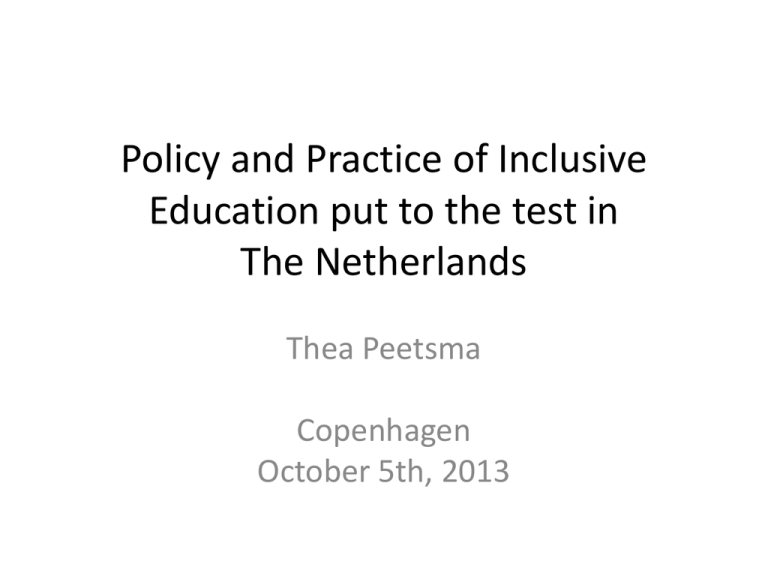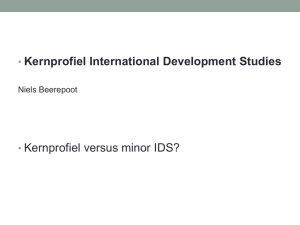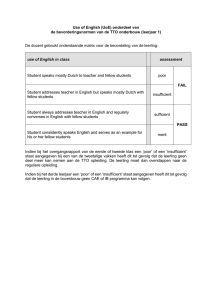other students with sen
advertisement

Policy and Practice of Inclusive Education put to the test in The Netherlands Thea Peetsma Copenhagen October 5th, 2013 Inclusive Education Salamanca 1994, statement of 92 countries who agreed that children with Special Educational Needs (SEN) get access to regular education “Those with special educational needs must have access to regular schools which should accommodate them within a child-centred pedagogy capable of meeting these needs” Attitude towards Inclusive Education What is your attitude towards inclusion of children with sen in mainstream education? Policies in The Netherlands • At the end of last century: Back to School Together Again (in Dutch: WSNS) policy • From 2005 on: Learner Bound Financing (in Dutch: LGF) policy, or in popular speech, Backpack (in Dutch: rugzakje) Back to School Together Again This policy was ment to include in mainstream schools children with Lighter learning and behavioural difficulties (lbd) or Mildly mentally retarded pupils (mmr) Practice • Partnerships between schools from one region or schools from one or more school councils • Teachers from (former) schools for special education can be consulted by teachers of mainstream schools concerning a child with sen in their class Testing the WSNS policy Comparing at-risk pupils’ development over 2 and 4 years in special and in mainstream education Study: Peetsma, T., Vergeer, M., Roeleveld, J., & Karsten, S. (2001). Types of Education Regular primary education Two types of special education: Education for pupils with learning and behavioural difficulties (lbd) is for pupils of normal intelligence who have problems in psychosocial functioning or specific learning difficulties. Education for mildly mentally retarded pupils (mmr) is appropriate for pupils whose learning difficulties are due to their low intellectual ability. Research questions Is the progress in academic performance and psychosocial functioning of at-risk pupils in inclusive education over periods of two and four years considered to be better than that of comparable pupils in special education? What processes at the level of the child, family and school account for the diverse development in academic performance and psychosocial functioning? Pupils in the study The pupils in regular schools were designated as being at-risk if their scores on standardized language or mathematics tests, or their teachers’ assessments of their school motivation or self-image belonged to the lowest 20% of the representative sample of 35,000 Dutch pupils on one or more of these variables Pupils from special education were matched with a comparable ‘pair’ from the at-risk pupils from regular education Matching – control variables Gender Ethnic and socio-economic background Type of school Age was controlled for in the matching of pupils Instruments: Tests on pupils’ cognitive functioning: standardized achievement tests on language and mathematics The same tests were used in regular and special education after testing their suitability in both Questionnaires on pupils’ psychosocial functioning: teacher assessments on a five-point-scale (1=definitely not true; 5=definitely true) of pupils’ self-image and attitude towards schoolwork (motivation) and older pupils’ self-assessments Interview guide on pupils’ development and processes in their education (32 students and their teachers) The following subjects were addressed in the interviews: self-image, well-being in school, social behaviour, attitude towards schoolwork, health, family culture regarding education, underachievement and need for individual treatment, prognosis or perspective on pupils’ education in the future, pupils’ investment in school and their parents’ involvement in school The interviews investigated also processes in pupils’ education and their lives outside school that could be influencing their development Results on consequences: • Consequences for the development of pupils’ socio-emotional functioning? • Consequences for the development of pupils’ cognitive achievement? Comparing students’ developments in special and regular education Comparing students’ cognitive developments in language and mathematics: better functioning on cognitive skills in regular education than in special education Comparing students’ motivation and selfconfidence (their socio-emotional functioning): no clear differences between students in regular and special education Processes in pupils’ education and their lives outside school No structural differences between students in regular and special education found Examples of developmental processes in a school context and context outside school: - academically low functioning, sporty, boy, socially well functioning with helpful parents - academically low functioning boy with an very unexperienced teacher - special school nearby Effects of Inclusion on students with SEN reviewed research Consequences for student socio-emotional functioning: mainly neutral to positive effects Consequences for student cognitive achievement: mainly positive effects Study: Ruijs, N.M. & Peetsma, T.T.D. (2009) Effects of Inclusion on students without SEN reviewed research Consequences for students’ social functioning: students are more positive regarding sen students, but students are less positive regarding sen students compared with the peers without sen Consequences for student cognitive achievement: comparable or better in inclusive classes but results maybe different for high and low achieving students Learner Bound Financing (backpack) policy (since 2005) Teachers from Expert Centres or (former) schools for special education can be consulted by teachers of mainstream schools concerning a child with sen in their class Children with sen can get assistence at school from the expert teachers Parents ask for the money and can decide together with the school how to use it in school Problems with previous research • No distinction between different groups of students without SEN • No research into effects of including students with different types of SEN • In two new studies these problems were met Testing Inclusion after WSNS and Learner Bound Financing (backpack) Consequences of these policies, working since 2005, for students with sen, their: Academic achievements Socio-emotional functioning Study: Ruijs, N., Peetsma, T.& Van der Veen, I. (2010) Research questions Is the presence of several students with sen related to the achievement and socio-emotional functioning of students with sen in inclusive education compared to students with sen who are included alone? Do these possible correlations differ for children with different types of sen? Sample • • • • • • • • PRIMA-cohort study Representative sample: 42,068 students 420 Schools Grade 2, 4, 6 en 8 Selection of students with sen Average age: 6, 8.2, 10.2, 12.1 1839 students with SEN 66.8% boys Categories of SEN Three categories of problems: (1) cognitive problems (62.4%), which included mild mental retardation, language and arithmetic difficulties, dyslexia and dyscalculia; (2) behavioural problems (27%) which included autism, problems with making an effort at school and externalizing problem behaviour; and (3) other problems (28.7%) including physical disabilities, internalizing problem behaviour and gifted children Instruments • Standardized language and arithmetic tests • Teacher assessments of students’ self-confidence, teacher–student relationship, effort, popularity, well-being at school, and behaviour at school • Students’ self-assessments of their socioemotional functioning: self-confidence on schoolwork, well-being at school, and social integration in the class Results on developments of academic achievements • No differences found between students with sen who were included alone, who were included in classes with a few other students with sen and students who were included in classes with more other students with sen • No differential effects for students with different types of sen Results on developments of socioemotional functioning • On five out of nine variables measuring socioemotional functioning, it did not make a difference to be the only one with sen or to be in classes with more students with sen • On some variables differences were found but it is quite complicated to interpret, also the interaction with differences in types of sen Testing Inclusion after WSNS and Learner Bound Financing (backpack) Consequences of these policies is working since 2005, for students without sen, their: Academic achievements Socio-emotional functioning Ruijs, N.N., Van der Veen, I., & Peetsma, T.T.D. (2010) Research Questions • Does inclusive education affect the achievement and socio-emotional functioning of students without sen? • Do the academic and socio-emotional effects of inclusive education differ for intelligent and less intelligent students without sen? • Do the academic and socio-emotional effects on typical students differ by the type of sen of the included students? Instruments • Standardized language and arithmetic tests • Questionnaires for socio-emotional functioning: both teacher and student assessments • Non-verbal IQ test • Students without sen were divided into several groups: typical students with no, a few and more than a few students with (certain types of) sen in their class Method: Sample • • • • • • • PRIMA-cohort study 420 Schools Grade 2, 4, 6 en 8 Average age: 5.8, 7.9, 9.9, 11.9 49.9% girls 1,839 students with SEN 27,745 students without SEN Results on typical students’ academic achievements • For academic achievement, no differences were found between students without sen in inclusive and non-inclusive classes • No differences between intelligent and less intelligent typical students in this Results on typical students’ socioemotional functioning For socio-emotional functioning, some differences were found, but the practical importance of these differences is unclear, since the effect sizes were small The functioning of typical students does not meaningfully differ by type of sen of the included students General results on student functioning in inclusive education • Better academic achievements for students with sen and no worse for typical students • The development of students’ socioemotional functioning is less clear but it seems in general not worse than in not inclusive classes Teachers • Teachers’ attitudes towards inclusive education • Relation of teachers with parents of students with sen Peetsma, T. & Blok, H. (Red.) (2007). Onderwijs op maat en ouderbetrokkenheid; het integrale eindrapport. [Fitting education and parents’ engagement] Amsterdam: SCO-Kohnstamm Instituut van de Universiteit van Amsterdam. Attitude towards inclusion What is your attitude towards inclusive education now? Publications in English Peetsma, T., Vergeer, M., Roeleveld, J., & Karsten, S. (2001). Inclusion in education; Comparing at-risk pupils’ development in special and regular education. Educational Review, 53(2), 125-135. Ruijs, N.M. & Peetsma, T.T.D. (2009). The effects of inclusion on students with and without special educational needs reviewed. Educational Research Review, 4 (2), 67-79. Ruijs, N., Peetsma, T.& Van der Veen, I. (2010). The presence of several students with special educational needs in inclusive education and the functioning of students with special educational needs. Educational Review, 62 (1), 1-37. Ruijs, N.N., Van der Veen, I., & Peetsma, T.T.D. (2010). Inclusive education and students without special educational needs. Educational Research, 52 (4), 351-390. Thank you for your attention Information: T.T.D.Peetsma@uva.nl


